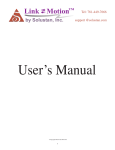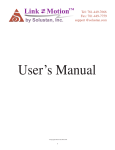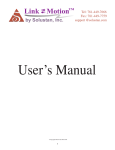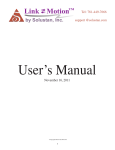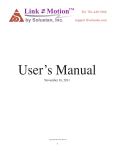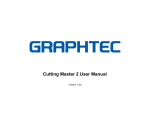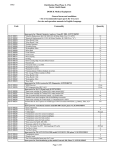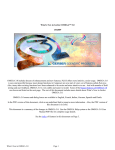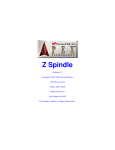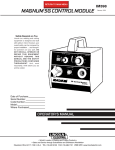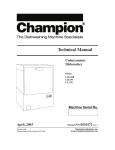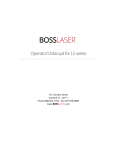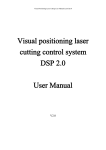Download Link Motion
Transcript
Link Motion™ by Solustan, Inc. Tel: 781-449-7666 Fax: 781-449-7759 support @solustan.com User’s Manual ©Copyrights Reserved 2003-2008 1 SOFTWARE LICENSE AGREEMENT YOU SHOULD CAREFULLY READ THE FOLLOWING TERMS. YOUR INSTALLATION OF THE PROGRAM INDICATES YOUR ACCEPTANCE OF THESE LICENSE TERMS. PLEASE READ THIS AGREEMENT CAREFULLY BEFORE INSTALLING THE PROGRAM. SOLUSTAN, INC. WILL ONLY LICENSE THE PROGRAM TO YOU IF YOU FIRST ACCEPT THE TERMS OF THIS AGREEMENT BY INSTALLING THE PROGRAM. IF YOU DO NOT AGREE TO THE TERMS OF THIS AGREEMENT, DO NOT USE THE PROGRAM; EITHER RETURN OR DESTROY YOUR COPY. These license terms apply to Your installation and use of the program, which program includes copyrighted materials and programs (collectively referred to as "Program"). This license is granted to You by Solustan, Inc. You may not use the Program contained in this Package to upgrade any existing Programs that You may have. The Programs contained in this package are intended only for New Users of LinkMotion and/or MaxMotion and not for any other use. 1. License. This Program is licensed and not sold. Title to the Program does not pass to You. Solustan owns copyrights in the Program. You obtain no rights other than those granted You under this Program License Agreement. The term "Program" means the original (including any revisions, enhancements, updates, or the like) and all whole or partial copies of it, including modified copies or portions merged into other programs. You are responsible for the use of, and results obtained from the Program. This Program may be used only on one machine at any one time. You may not reverse assemble or reverse compile the Program, except as specifically provided by law, without the possibility of a contractual waiver. You may not sublicense, rent, lease, or assign the Program. 2. Disclaimer of Warranty and Limitation of Liability. THE PROGRAM AND ANY OTHER PRODUCT WHICH WE PROVIDE TO YOU AS PART OF OUR SERVICE ARE PROVIDED "AS IS." EXCEPT AS SPECIFICALLY SET FORTH HEREIN, NEITHER WE NOR OUR LICENSORS MAKE ANY WARRANTIES, REPRESENTATIONS OR CONDITIONS OF MERCHANTABILITY, QUALITY, AND FITNESS FOR A PARTICULAR PURPOSE RELATING TO OUR PROGRAM, SERVICES, AND/OR RELATED PRODUCTS THAT WE OR OUR LICENSORS PROVIDE. 3. IN NO EVENT SHALL SOLUSTAN BE LIABLE FOR ANY DAMAGES RESULTING FROM THE USE OR MISUSE OF THE SOFTWARE OR THE ACCOMPANYING MANUAL INCLUDING BUT NOT LIMITED TO DAMAGES FOR INJURY TO ANY PERSON OR PROPERTY. THE PROGRAM IS DESIGNED TO WORK WITH MACHINES AND AS SUCH, ANY PART OF THE SYSTEM MAY MISBEHAVE. IT IS IMPORTANT TO TAKE ALL THE NECESSARY PRECAUTIONS IN OREDR TO AVOID EQUIPMENT DAMAGE AND/OR INJURY. 4. WE DISCLAIM ANY WARRANTY OF TITLE OR OTHER WARRANTIES FOR ANY THIRD PARTY'S OFFERING(S) OR PRODUCT(S). ALL SUCH WARRANTIES AND REPRESENTATIONS ARE HEREBY EXCLUDED. WITHOUT LIMITATION, NO WARRANTY IS GIVEN THAT THE PROGRAM OR PRODUCTS ARE ERROR-FREE. WE, INCLUDING OUR LICENSORS, DISCLAIM ANY LIABILITY OR RESPONSIBILITY ARISING FROM ANY CLAIM THAT YOUR ACCESS OR USE OF THE PROGRAM, SERVICE, AND/OR RELATED PRODUCTS WE PROVIDE INFRINGE ANY THIRD PARTY'S INTELLECTUAL PROPERTY RIGHTS. IN NO EVENT ARE WE OR OUR LICENSORS ARE LIABLE FOR: A) DIRECT, SPECIAL, INDIRECT, CONSEQUENTIAL OR INCIDENTAL DAMAGES EVEN IF WE HAVE BEEN ADVISED OF THE POSSIBILITY THEREOF INCLUDING, BUT NOT LIMITED TO, LOST PROFITS, LOST BUSINESS REVENUE, OR FAILURE TO REALIZE EXPECTED SAVINGS; OR, B) ANY CLAIMS AGAINST YOU BY ANY OTHER PARTY. This Section applies to all claims by You irrespective of the cause of action underlying Your claim, including, but not limited to: a) breach of contract, even if in the nature of a breach of condition or a fundamental term or a fundamental breach, or b) tort including but not limited to negligence or misrepresentation. In no event are We or Our dealers liable for any damages arising from Your failure to perform Your responsibility in connection with this Program License Agreement, or arising from any cause beyond Our control, including but not limited to delay in the performance of Our obligations or misuse of Your User IDs. All limitations and disclaimers stated in this Section also apply to Our Product Licensors as intended beneficiaries of this Program License Agreement. Any rights or limits stated herein are the maximum for which we are collectively responsible. 5. Termination. This license is effective until terminated. This license will terminate immediately without notice from Solustan, Inc. if fail to comply with any of its provisions. Upon termination you must destroy the Software and all copies thereof, and you may terminate this license anytime by doing so. 6. General. You are responsible for payment of any taxes, including Your personal property taxes, resulting from this Program License Agreement or Your use of the Program. You agree to comply with all export laws and regulations. Neither party may bring an action under this Program License Agreement more than ONE years after the cause of actions arose. This Program License Agreement and all Your rights and obligations are governed by the laws of the State of Massachusetts. 7. LinkMotion and MaxMotion softwares are protected with an ID (dongle) key. If the ID key fails for some reason, you could return it for replacement. As long as Solustan can identify the key to be the one issued by us, we will replace it for a fee. On the other hand, if you lose the key, you will be required to buy another license at a full price of the software. It is very important to safeguard the ID key. Solustan, Inc. 165 Chestnut St., #200, Needham, MA 02492 Tel:781-449-7666 Fax:781-449-7759 email: [email protected] 2 LinkMotion Detail Installation Instructions Make sure that your computer has at least the following: Windows XP operating system with Service Pak 2 or 3 and Microsoft .NET 2.0 Framework installed Processor speed of at least 800 MHz 512 MB RAM preferred, contact us for laser raster work under virtual controller 100 MB of Hard drive free space CD-ROM drive Screen resolution of at least 800 x 600 2 USB 2.0 ports for LinkMotion USB product - Do not use any other USB 1.1 connection devices. 2 USB Ports for all board (Controller card) level products, Install the board (Controller Card) and the related software per manufacturer’s instructions before installing Linkmotion. 1 parallel port and one USB port for all LinkMotion Virtual controller products. Use Keyboard and mouse with PS2 connection only for all LinkMotion Virtual controller products working with Parallel Port. Note that you must have administrative privileges on the computer in order to install LinkMotion. Now insert the LinkMotion installation CD into your CD-ROM drive. If the Auto-run feature is enabled, Windows will start the LinkMotion installation automatically. If not, browse the CD drive in Windows explorer and double-click on the "Launcher.EXE". You can also click separately on Sentinal Protection Installer 7.4.0 and it will install I.D. key driver first. Next you can click on the Setup.exe and it will install LinkMotion driver. Keep the ID key handy but do not plug it in yet. You will be asked if you want to install the ID key driver; answer "yes" (Demo users do not need to install ID key driver) if you have not already installed the ID key driver and follow the on-screen instructions. Insert the key after full installation is complete. Once the ID key driver has been installed, the LinkMotion installation will start. The software is protected by the ID key. If the ID key fails for some reason, you could return it for replacement. As long as Solustan can identify the key to be the one issued by us, we will replace it for a fee. On the other hand, if you lose the key, you will be required to buy another license at a full price of the software. It is important to safeguard the ID key. Most of the installation process is self-explanatory. You can stop the installation at any time by clicking "Cancel". 3 When you get to the License Agreement dialog (see below), you must click "I Agree"; otherwise you will not be allowed to continue with the installation. 4 After you have agreed to the License Agreement, you will be asked to specify the installation folder. In most cases you can leave this at the default value. You will also be asked to specify who will be able to run LinkMotion on this computer. In most cases you should specify "Everyone". 5 Later during the installation you will be asked to Choose your application and Choose your machine for installation. These choices will determine how LinkMotion will behave and what hardware it will be connected to. Note that some machine names appear under both Virtual Controller applications and HPGL applications, so make sure that you select the correct application before you select the machine. If you have any questions about which application and/or machine you should select, check your LinkMotion installation CD, which will be marked with this information. Choose your Application ❑ ❑ ❑ ❑ ❘❑ ❑ ■ ❑ ❑ Virtual Controller for Engraving HPGL Controller for Engraving HPGL Controller for Vinyl Cutting Virtual Controller for Marking Laser Machines for V/C and Boards Virtual Controller for CAM Motion Control Boards MaxHPGL/MaxUnica Virtual Controllers for FoamCutting Choose your Machine ________________________ ________________________ ________________________ ________________________ ________________________ ________________________ _________Galil___________ ________________________ ________________________ 6 During installation, if a dialog pops up warning you that you are installing an untested driver, click on "continue anyway". This warning will be removed in a future release. Click on "Close" when the installation is complete. Setting up the Default Printer: In most cases you will want the LinkMotion printer to be your default printer. Go to the Start button and open the "Control Panel>Printers and Faxes" menu and find the LinkMotion printer (which has your machine name or Controller Board name or LinkMotionUSB for USB product). Check with us if your machine is not listed in Choose your machine. Following are some examples: Printer Names Scanlab RTC4 Scanlab RTC3 Leetro MPC6515 LinkMotionUSB Galil LinkMotion Application Laser Macines for VC and Boards Laser Macines for VC and Boards Laser Macines for VC and Boards Motion Control Boards Motion Control Boards 7 Universal Laser Wizzard Newing Hall New Hermes 1219 EGX 20 EGX 400 LinkMotion for VC and Boards Virtual Controller for Engraving Virtual Controller for Engraving Virtual Controller for Engraving HPGL Controller for Engraving HPGL Controller for Engraving Right click on this printer and select "Set as Default Printer". Post-installation setup and configuration: In all cases you will have to configure LinkMotion before you can use it. Open the LinkMotion Control in the system tray in the lower right of your screen. Pad by double-clicking on the LinkMotion icon Note that you must click "OK" or "Apply" for any changes to take effect. ControlPad, Material Properties, Machine Properties, Motor Parameter, Origin setup, General Options, Laser Controls, Galvo and Controlled Laser are the different tabs available for proper settings of your machine. These tabs are designed for specific applications and you will see only related to your application. Please understand the functions of these and setup properly before you start using your machine. 8 LinkMotion for Laser machine boards like Scanlab RTC4, RTC3, Scanalone4, Leetro MPC6515, IPG Laser, etc.): Install the board (laser Controller cards) and the related software per manufacturer’s instructions. Boards that needs to be installed inside your computer should be installed first. USB based controller cards may be connected externally. Make sure you have set up your machine driver as default printer driver in your XP system. Click on the start button and select Printers and Faxes. Right click on the driver name Leetro MPC6515 or Scanlab RTC4….. Select this as ‘Set as default printer’. Boards that have USB connections can be connected with the USB cable to your computer and it will recognize the new hardware. There are many possible reasons for the USB communication malfunction: 1. Windows operating system temporarily suspends USB devices if they are not used and dormant for a period of time. 2. Windows screen savers or power saver mode creates interruptions in USB communication from time to time. 3. If for some reason, USB interface cable between the controller and the PC were removed or came loose, communication will be interrupted. Upon connecting back, Windows will recognize the device. However, LinkMotion driver needs to be launched again to establish the communication with the controller. Right click on the LinkMotion icon in the system tray and select EXIT. Go to the Start button in Windows and re-launch LinkMotion. 9 Uninstalling LinkMotion: Please make sure of the following before you uninstall: Your specific machine related settings are saved as LinkMotion.ini file. This file can be saved from General Options Menu and simply click on the Save button and give whatever name you prefer. You can also navigate where in your hard drive you want to save it. Different users can save under different names. Similarly you can Load that file back after another installation of LinkMotion by going to the General Options menu and clicking on the Load button. Navigate to the file from your computer where you saved it earlier. Restore Default button allows you to load default installed INI file that is supplied with LinkMotion. It is very important to exit Link applet and Re-launch the applet when you change and select another INI file for it to be effective. Uninstall LinkMotion Procedure: Make sure the LinkMotion applet is closed. Open the Start menu and select the Control Panel. Double-click on Add or Remove Programs. Look for LinkMotion entry in the list and click on that. Select "Remove" and answer "Yes" when it asks you if you really want to remove LinkMotion. If you want to delete your existing INI file following is the procedure: In the hard drive Find folder name Document and Settings> Folder with users (your own name) name> Folder name Application Data> Folder name Solustan> Folder name LinkMotion> LinkMotion.INI. Delete this file. If you are uninstalling before installing a new version of LinkMotion, you do not need to uninstall the Sentinel (I.D. key) Driver. Sentinel Driver can be removed the same way as LinkMotion but simply select Sentinel Driver. 10 LinkMotion and Galil Board: The LinkMotion driver comes with a small application that resides in the System Tray. The System Tray is the lower right bar of the Windows screen. Double click on the LinkMotion icon to bring up the application. Based on the selection, the Control Pad will show up in English, Spanish, or symbols. Control Pad can be designed easily into any of the languages of the world. Your computer should have Windows XP operating system with Service Pak 2 (SP 2) installed, one parallel port (on original mother board) and one USB 2.0 connection. Also you should install Microsoft .NET Framework Version 2.0. This is available form Microsoft’s web site for you to download freely: Microsoft.com>Downloads & Trials>Download Center>.NET Framework Version 2.0 Do not use Keyboard or mouse connected with USB connection. Use PS2 connections. First follow proper installation and set up for hardware and software of the Galil boards. Now install LinkMotion following the instruction that you received with your LinkMotion CD. First part of the installation is for LinkMotion I.D. Key driver and the second part will be the LinkMotion driver application. Make sure to select Motion Control Board under application and Galil under machine name during the last part of the LinkMotion installation. Warning for Control Pad (All functions may not be supported for board level products): Please avoid using the mouse after you have sent the job for the output. Once the job is done, your mouse should be available for use. Use the ‘Zero’ or the ‘Space Bar’ key on your keypad to Pause. You will see a message box asking you if you want to Continue or Quit the job. (Some times this message box is in the back of your Control pad and you can bring it to the front simply by clicking on the system tray’s active LinkMotion application.) At this point you can go to LinkMotion and change the speed or depth in the materials menu, click apply and then click Yes to Continue the job or No to stop the job completely. Keep in mind that if it is in the 'Move Mode' between the shapes or letters, it may not pause. When jogging the machine do not press three keys together, it may cause undesirable results. Some times pressing two keys together for both X and Y movements can cause machine to continue moving in one direction even if you are no longer pressing the key. Pressing the same key again or the opposite direction key should stop this unnecessary movements. Do not use the arrow keys elsewhere on the keyboard in place of the Control Pad keys. 11 Control Pad (All functions may not be supported for all board level products): The Control Pad is operated using the numeric keypad, the right side of the extended PC keyboard. Click on the Apply button after any changes you make on any of the Tabs (Menus). Changes are effective only when you click on these buttons. Limit switches show up at the top of the Control Pad for each axis. If switches are present and properly configured, it will show green color when not tripped. Move the table in any one of the axis until the switch is tripped, the green color will change to red. Settings for the switches are in the Origin Setup menu. Reset Counter – Basic function of this is to Reset Counter to 0 value for each X, Y and Z axis positions. If you move the tool any where on the table, the X, Y and Z the counter will display the actual position of the tool. If you then click on the Reset Counter it will make all the display values to 0, 0, 0. 12 Machines without the Home switches or selecting a new staring position on any machines are some of the useful functions of Reset Counter button. Move To 0,0 – Clicking on this button will make your machine move your X and Y position to 0, 0 location if the counters show values other than 0, 0. This is a useful function for resetting back to the start position for the machines without the Home switches. Clicking on the Solustan logo will take you to Solustan web site, if the computer is online and connected to Internet. All the blue colored keys are designed to move X, Y, and Z axis with respective direction. Following are the keys for each axis X left (4), X Right (6), Y Up (8), Y Down (2), Z Up (-), Z Down (+) and Move Fast (5). Move Fast Key (5) is pressed along with X or Y key movement to make it move faster. For faster movement you also need to have faster speed in the Move section of the materials menu. Move value is responsible for two functions. One function is fast jog speed and second function is tool up speed when it lifts up between the shape while doing a job. Z Ref key (*) is clicked when the tool is just touching the top of the material. LinkMotion will remember the reference surface for the job. It will use the Z reference to calculate the moves in the Z axis for the depth and lift as it processes the job. If your machine has the home switch for Z axis and if it is activated in LinkMotion, Z Reference value is automatically calculated. If your machine does not have the home switch then you can declare the Z Reference value in the Origin setup in the Z offset for Start Position and it will go up by that distance with the Z Reference Key. If your Z stroke is 3 inches or more and you do not care to travel the full stroke while seeking the home switch during homing operation, you could declare Z home switch not enabled and declare your own Z-up stroke in the Z-offset in start position of Origin setup menu. HOME key (7) will move the machine to its Home position, if the machine is equipped with home switches. Machines may have home switches in X and Y axis or all the three axis. I/O Keys (1), (3), (. or Del) and (9) are available for I/O 1, I/O 2, I/O 3 and I/O4 controls. These could be used to control Z axis movement in case Z axis is not motorized but it is solenoid and is controlled by air valve, for example. Can also be used for lubrication of tools, vacuum control, laser control, red diode, air, water etc. Each click of the keys can toggle the I/O position. User can set to make the action momentary or toggle by way of settings in the LinkMotion .INI file. Spindle Control for CNC type application or Air Control for Laser type application - Key (9) I/O 4 is used to control spindle motor or air in case of laser application. Each click of the keys will toggle the I/O position. The big 0 (zero) or Space bar key is available to stop processing of the job anytime. When job is being processed it is very important to remember not to touch the mouse and the rest of the keyboard. 13 Num Lock and \ keys are available only when machine is in motion. These keys can decrease or increase the speed of the X, Y movements of the machine. Do not keep this key pressed for long time. Simply press and release gently each click of the key will decrease or increase the speed according to the settings in the LinkMotion.INI file. OnTheFlySpeedChange=4 is a default value in the INI file. This number works in percentage value of the original speed specified in the Job feed rate of the Materials menu. When the machine is in motion user can decrease the speed by pressing Num Lock Key. Similarly user can increase the speed by pressing the / Key. Once the job is done the speed again goes back to what is declared in the Job Feedrate of the Material Properties. Control Pad in Spanish language: 14 Go into General Options menu. Look at Control Pad Labels. Arrow to the right will show you the choices you have. Here select the Spanish Control pad and click on Apply button. Now you will see the Spanish control pad. Control Pad with Symbols: Go into General Options menu. Look at Control Pad Labels. Arrow to the right will show you the choices you have. Here select the Symbol Control pad and click on Apply button. Now you will see the Symbol control pad. 15 Materials Properties: Pull down the Material Properties menu to observe a selection of various materials. Pre-select the values of speed and tool positions for each of the materials. The default values are simply that. LinkMotion can be employed to work with many different types of machines. Hence, there is no single value appropriate for all different machines. User’s experience will dictate the values for his/her machines. The values can be inches per second or millimeters per second or centimeters per second. General Options menu allows you to make your selection for this measure of units. 16 Jobs can be designed in color and job feed rate speeds can be defined as percentage of declared values for each of the color. One of the applications of this feature is to design the same job in different colors on different layers and sequence the layers appropriately. Following are the color/pen values for the LinkMotion printer driver. RGB values are given in percent. Pen number --------------1 2 3 4 5 6 7 8 9 10 Color -------Black Red Green Blue Cyan Magenta Yellow Orange Brown Purple R --0 255 0 0 0 255 255 255 128 128 G --0 0 255 0 255 0 255 128 0 0 B --0 0 0 255 255 255 0 0 0 128 If you did not create a color palette with the above RGB values, our understanding of the way GDI handles this is that GDI will convert the object's color to an RGB value using whatever color correction model is in effect, then will do a least-squares fit to the 10-color palette (whichever of the 10 colors is closest to the color of the object on a least-squares bases will be the color that is sent to the printer driver). Job feed rate is the speed when the tool is engaged into material and working. Bringing your arrow on the number that shows Job Feedrate (100%) for each pen and Double clicking on the number should open a box that will allow you to change this number. If your job federate in tool speed is 2in/sec and you make the red pen to give output at 50% then job should run at 1in/sec. Jog speed is when the user is jogging the machine with the help of Control Pad. Move speed has two functions, it is the speed when the tool is retracted and the machine is moving to the next shape after finishing the previous one and it is also used for fast jogging (holding down fast key while keeping the directional key pressed). User can set up separate speeds for Z feed up and Z feed down. Depth is the value declared for tool to travel in the material. Once the top of the material surface is determined, depth value controls the movement of the tool in the vertical axis. Maximum depth per pass (This may not be available for all board level products) is the value declared if you wish to do your job in multiple passes. For example if you have selected 0.15 in to be your Depth value and you want to do your job in three passes you can declare 0.05 in value for Maximum depth per pass and your job will be done in three passes. When you send the job you should see the dialog box for Pause Between passes. User can select to pause between the passes or continue 17 without the pause in the dialog box when doing the job with multiple passes as shown on the screen below. Your tool will always return to 0, 0 for X, Y position (Regardless of weather you have checked or unchecked in the origin setup for Return to 0,0 after job) and then do the next path. If you declare 0 value in multiple pass it will always do the job in one pass. Lift is the value for tool to lift between the shapes to do the job. If you have several inches of travel available for Z axis then it saves time to plug in the lift value where it does not travel all the way up for Z axis between the shapes and instead it travels only by the Lift value and saves time. Dwell is the amount of time in seconds and fraction of seconds the tool will stay at the same position in the material before making X, Y move and after finishing the shape to cut the material. The three levels of power determination is useful in case an electrical solenoid is required to control downward force, for example. A control panel for laser machine would have eight levels of selections for power and speed of operation. 18 Machine Properties: Board level products are also different for I/O support. Please check before using these functions. If Enable I/O control 1 is checked, it will turn the I/O ON while cutting/engraving a shape during a job and turn itself OFF at the end of completing the shape. The I/O will stay OFF during the traverse/Move motion to the beginning of the next shape. You can test the operation of the I/O by either clicking on the Key 1 button with a mouse or depressing the key on the Control Pad. If Enable I/O control 2 is checked, it will turn the I/O ON while cutting/engraving a shape during a job and turn itself OFF at the end of completing the shape. The I/O will stay OFF during the traverse/Move motion to the beginning of the next shape. You can test the operation of the I/O by either clicking on the Key 3 button with a mouse or depressing the key on the Control Pad. 19 Z axis can be selected as solenoid or air controlled. It may be attached to I/O 1 or I/O 2. If Enable I/O control 3 is checked, it will turn on and off with the job execution. You can check by clicking Key Del (.) on the Control Pad. If Enable I/O control 4 (Spindle) is checked, it will turn on and off with the job execution. You can check by clicking Key 9 on the Control Pad. The value of delay can be entered in seconds and fraction of seconds in the Spindle Delay area. This delay value will allow the spindle motor to reach its speed before the tool plunges into the material. Safety, Limit, and Emergency controls Pin 15 on the parallel port is available for connecting safety, limit, and emergency switches. We will expect Logic 0 on pin 15 for the machine to operate normally. When we see logic 1 on pin 15, the job will be aborted or will not start. Once job is aborted, it cannot be recovered. It has to be restarted. We feel Logic 1 is failsafe and requires active response from the safety apparatus for it to work properly. Directions for X, Y and Z can be set properly here by checking or un-checking the direction button. If the axis movements are opposite to the intended directions, the direction or directions can be reversed without changing the wiring. The maximum travel distances of the machine in X, Y and Z axis is shown here. The maximum travel numbers (in other words the size of the table) should match the Design applications you are using like Corel Draw or Auto Cad for the job to appear in the expected place on the machine. Linear travel per revolution (lead screw pitch) is shown here and you can change this if necessary. There are unknowns in a system from time to time. These are the pitch of the screw (2 turns per inch, 5 turns per inch, etc.), full step angle of a step motor (200 full steps for 360 degree turn, etc.), and micro stepping of the driver. If you know any two of the three, the third one can be determined using nudging feature of the Control Pad. Typically, most of the Control Pad is activated using physical keys of the keyboard and using them with fingers. The nudge feature is activated using a single click of the mouse on the appropriate key on the screen. Nudge a distance by declaring the distance in the General Options. Next, measure the actual distance moved by the machine. Make the necessary correction of the value for the unknown parameter until you get the desired distance by nudging. Cylindrical axis choices will be offered if the machine is equipped with it. It is very important to quit and Re-launch LinkMotion applet after you make this selection. Maximum Travel size of the table in X or Y will change when you Enable Cylindrical Axis Support. You do not need to enter this new size in Maximum Travel area in LinkMotion applet. However, it is very important to remember the dimensions and create that Table size in your design applications like Corel or Cad. Selecting X or Y whichever is the cylindrical axis for your machine. Motor Gear Ratio and Job Piece Diameter is entered for your job in the bottom section. 20 Motor Parameters: Servo motors might have different settings in board level products. Please check before using it from here. Above values are determined by the motor manufacturer. Enter Full steps per revolution values for each axis depending upon the motor and the lead screw size specifications. Declare Toolhead Maximum Acceleration values for the motors in each of the axis in in/seec^2. You may need to adjust this numbers to get proper acceleration constants for smooth motion. Check with your machine manufacturer for the correct numbers required for the machine. In absence of that, you should start with a number between 25 and 100 as a safe starting point. Set the Microsteps per every full Step for your system for each of the axis. This is necessary only if you are using step motors in your system. This number is derived from the Amplifier driver used for 21 your motors. In case of servo motors, you need to make sure that the multiplication of numbers in this area as well as in the number of full steps per revolution of the motor in the Motor parameters match your encoder number for the feedback. Generally, it would be a good idea to declare number 1 as the number in microsteps per every full step and the encoder resolution number in the number of full steps per revolution in the motor parameters location. Maximum Motor RPM number should be selected by the specifications given by your motor manufacturer. 22 Origin Setup: All functions may not be supported from board level products. Return to 0, 0 after job (Go Home After Job) – If you have not checked this box then after finishing the job it goes up for Z axis and stops at the position where it finished the last shape. It does not move it’s X and Y position. It does not go to the start position. Checking this box makes your tool go back to the starting position (parking position) for X, Y and Z axis. If your machine has the limit switches and limit switches are enabled it will sense those switches and park the tool to its home position. Start Position: Bottom Center, Bottom Left, Bottom Right, Center, Top Center, Top Left and Top Right are the choices. If your Home Position and Start Positions are the same following are the selection necessary: 23 Some are not available at this point. Home Position Selection Start Position Selection Bottom Left Bottom Left Bottom Right Bottom Right Top Left Top Left Top Right Top Right Job start position can be different than the Home position. Job start position may be, - Where the jig is positioned (Home Position) - Center of a machine in case of a vise type machine with offset values in X and Y where both jaws move - Top center of a machine with offset value in X only in case of a machine where only bottom jaw moves In above situations and others, it is necessary to select Start Position and declare offset values for X and Y appropriately. If you suspect that there is a problem with one or more limit switches and it is hindering your production, check the Disable limit switch box at the top. This will allow the operation of the machine while the limit switches are being investigated. 24 Motion Control Board – Galil: First follow proper installation and set up for hardware and software of the Galil boards. Make sure of the parameters and other necessary settings that Galil recommends for the proper operation of the board. Now follow installations and settings for How to use LinkMotion. Following is the information for using the Galil board with LinkMotion. 25 Settings required for Galil: Disable limit switches. The limit switches are under Galil board control. All LinkMotion does is that it issues Home command, when clicked Home on the Control Pad. The software is tested for only Top Left starting position. That is the position that should be selected and accordingly wired on the machine using Galil control board. By doing this, there will be no surprises for the starting position of the job. Initially, dry run a few jobs just to become familiar with the workings of the LinkMotion along with the Galil board. Two things to remember: 1. Once you select Galil board on PCI slot or on the Ethernet connection, selecting an output port like LPT1 or anything else is not relevant and not necessary. It is ignored by LinkMotion. 2. Galil boards may not be used for controlling laser machines. You may not see a way to handle bitmaps in this option. A note on Galil job structures and user-defined commands: The Galil user interface allows the user to define the following command sequences which will be sent to the board during a job or during jog operations: "Start Job", "End Job", "Start Shape", "End Shape", "Color Change", "Start Pause", "End Pause", "Abort Job", and "Motor Setup". 26 Color Change commands, and handling of color changes, are not currently handled. The Galil interface assumes that the Z axis handles the cutting tool. For situations where the tool is not handled by a Z-axis motor, the user should make sure that the "Z axis is solenoid" box is checked on the Machine Properties tab. During a job, commands are sent to the Galil board in the following sequence: - "Motor Setup" commands - "Start Job" commands - "CAS" command - (command sequences for shapes, see below) - "End Job" commands For a shape, commands are sent to the Galil board in the following sequence: - "LM XY" command - "VS", "VA", and "VD" commands (set "move" speed and acceleration) - "LI" command(s)s to move to a shape's starting position - "BGS" command - "LE" command - wait for motion complete - "Start Shape" commands - move Z axis down if not a solenoid - Wait for dwell time - "VS", "VA", and "VD" commands (set "engrave" speed and acceleration) - "LM XY" command - "LI"/"BG" command pairs to follow the shape's path - "LE" command - "BGS" command - wait for motion complete - move Z axis up if not a solenoid - Wait for dwell time - "VS", "VA", and "VD" commands (set "move" speed and acceleration) - "End Shape" commands For jogging, commands are sent to the Galil board in the following sequence: - "Motor Setup" commands - "AC", "DC", and "JG" commands for the appropriate axis - "BG" command for the appropriate axis - wait for key release - "ST" command for the appropriate axis During a job when a pause is requested, commands are sent to the Galil board in the following sequence: - "VS ?" (query for current velocity) - "VS 0" (set velocity to zero) - move Z axis up (if necessary) if not a solenoid - "Start Pause" commands 27 - wait for user to allow job to continue - move Z axis down (if necessary) if not a solenoid - "End Pause" commands - "VS" command to restore previous velocity During a job when a job abort is requested, commands are sent to the Galil board in the following sequence (note that a job abort is initiated the same way as a pause job): - "VS ?" (query for current velocity) - "VS 0" (set velocity to zero) - move Z axis up (if necessary) if not a solenoid - "Start Pause" commands - wait for user to abort job - "Abort job" commands User can modify and write their commands. 28 General Options: There are just a few things in the General Options screen. Units of choice can be selected from inch, mm, or cm. The Nudge will allow the axis to move a fix distance when any axis is moved with a single mouse click on the keys that move the X, Y and Z axis when Control Pad tab is open or selected. Control Pad Labels: Arrow to the right will show you the choices you have. Here select the English, or Spanish or Symbol and click on the Apply button. Now you should see the control pad you have selected. Enable Braille support is an optional feature and it is designed to drill dots. This is used for creating Braille signs. Adot is the font we provide when Optional Braille support is purchased. Selecting this 29 option makes your tool travel to the begin point of each shape and go down to create a mark or a hole and go back up and go to the begin point of the next shape. Hide OEM setting is for OEM customers only and it hides some of the control pad settings as requested. Save Settings: Save: Once the machine is properly configured and is working well, it is advisable to Save the settings on the hard disk drive. This is saved as LinkMotion.INI file. LinkMotion.INI file is located on your hard drive C:\ Document and Settings> Folder with computer users name> Folder name Application Data> Folder name Solustan> Folder name LinkMotion> LinkMotion.INI. Click on the Save button and it will ask you to give a file name. Make sure to remember the file name, and where you are saving it. You can navigate on your hard drive where you want to save. You can also rename the file with what ever is easy for you to remember. Mostly our customers rename the file with their machine name. Load: In case the LinkMotion needs to be loaded again from the CD supplied by Solustan, or you need to load upgraded version the user will be able to reload all the settings with your .INI file without wasting any time. For loading the settings back select Load button and navigate to the saved .INI file and click on Apply and OK. Now click on the right mouse button when you are on the LinkMotion appellate and exit the program. Go to the start button and launch back LinkMotion. You should see all your saved settings here now. Restore Defaults: Clicking on this button will load default LinkMotion.INI file that we supply with the LinkMotion driver. It is very important to exit Link applet and Re-launch the applet when you change and select another INI file for it to be effective. LinkMotion driver mode of operation: General purpose mode – This is loaded by default. This mode is used when you use Corel, AutoCAD type of design softwares and use LinkMotion to send files to your machine. Only MaxMotion users do not need to use this mode. Instructions for I.D. key Upgrade: This is required only when you need to upgrade the features offered or upgrade to use with the new version of LinkMotion or upgrade the number of executions for the I.D. Key. 30 To upgrade your I.D. key you will receive a code as a text file from us. Note pad or Word pad type of utility should open this code. Simply highlight the code with a cursor. Right mouse click and select Copy. Now launch LinkMotion Icon. Click on the General Options menu. Click on the button Update I.D. Key. A dialog box will open. Right mouse click inside the Authorization Code box. Select Paste. Click OK. Click on OK in General Options menu. Now right mouse click on the LinkMotion icon and select Exit. Go to the Start button. Select All Programs. Select Solustan folder and select LinkMotion application. Now you will see a LinkMotion Icon on the bottom right again. You are all set to work with your updated I.D. Key. 31 32 Application Compatibility with LinkMotion: Go to www.solustan.com/support and download instructions for the appropriate design application you might be using. Some applications have their own limitations and mostly it is listed in the document. We are adding information as we test with respective applications. 1. Corel Draw version 9, 10, 11, 12, 3X 2. Corel Paint Shop Pro (Raster Only) 3. Adobe Illustrator 4. FreeHand MX 5. EngraveLab / SignLab version 6.0 and higher 6. FlexiExpert 7. AutoCAD version 14 and higher 8. DolphinCAD specially designed version for LinkMotion 9. Rhino 4.0 Beta 10. Instant Engineer 14 11. IntelliCAD (AcceliCAD) 12. BarTender (Raster only) 13. Microsoft Word (Raster only) 14. PhotoShop (Raster only) 15. Gerber's ArtPath 16. MaxMotion 33 Frequently Asked Questions General Questions for LinkMotion: 1. When should I plug the ID key (software protection key) in the USB port at the time of installation? Start installing the software for LinkMotion or MaxMotion. Installation procedure will tell you to insert the key or you wait till you have installed the software successfully before inserting the key in one of the USB ports. This key is required in your computer all the time while you use LinkMotion or MaxMotion software. In case of installation of LinkMotion for USB you should plug in the ID key after it finishes complete installation for LinkMotionUSB. 2. What options are available to me if I lose the ID key? LinkMotion software is protected with an ID (dongle) key. If the ID key fails for some reason, you could return it for replacement. As long as Solustan can identify the key to be the one issued by us, we will replace it for a fee. On the other hand, if you lose the key, you will be required to buy another license at a full price of the software. It is very important to safeguard the ID key. 3. Do I need to access LinkMotion driver software once loaded? Generally, you simply deal with your job design software and your machine. We do provide an accompanied settings application. This application can be invoked from its icon in the SysTray area. This application will allow you to jog the machine in all axis, go home if the machine is equipped with home switches, surfacing, pausing a job, setting up feed rates and other speed settings, cylindrical work settings, laser related settings, port selection, and multitude of other settings based on the type of machine you are having. 4. How do I know if my LinkMotion is installed properly? When you launch LinkMotion applet does it show the title “LinkMotion for Your Machine Name – Ver. 1.5.4” (version that you have). If this is not proper you may have installed the wrong application or for the wrong machine. You need to uninstall and re-install LinkMotion again by windows standard uninstall procedure. In case of LinkMotion with USB Controller you should see the title LinkMotion for LinkMotionUSB. When you see the title “LinkMotion for Your Machine Name – Ver. 1.5.4” (Demo Mode). LinkMotion is in Demo mode and your ID key (dongle) is not recognized. Either The Sentinel Protection driver (ID Key driver) is not installed properly or ID key is not proper for the application 34 you are using. User may need to reinstall the Sentinel driver or get in touch with us for the proper license. 5. How do I access LinkMotion driver software for various settings? This application can be invoked from its icon in the SysTray (Lower right corner) area. This application will allow you to jog the machine in all axis, go home if the machine is equipped with home switches, surfacing, pausing a job, setting up feed rates and other speed settings, cylindrical work settings, laser related settings, port selection, and multitude of other settings based on the type of application and the machine you are having. 6. How do I select and set up my machine? The selection of the machine takes place during the installation of LinkMotion. Read Install and Uninstall LinkMotion part of the manual available on your CD. Latest files are in the folder name Manual-PDF. Please open appropriate file for the application you have purchased LinkMotion for and follow the instruction. 7. I click on Z axis and I do not see any movement on Z axis. Why? You may have solenoid controlled Z axis or motor control Z axis. In case of solenoid Z axis you can see the control from the I/O 1 or I/O 2 depending on how it is connected. Some laser machines also may require to select Z to be solenoid and that removes Zaxis related selections to work properly. In case of motorizes Zaxis it should move up and down by – and + keys on the control pad. Also, it is possible that you may have selected a wrong machine while installing LinkMotion. Laser applications are designed where you need to select Z axis to be solenoid and that will gray out Z axis motor related controls. 8. My machine is connected. I can jog the machine using the ControlPad. However, the directions are wrong. What do I do? Launch LinkMotion from SysTray. Go to Machine Properties menu. Reverse the direction of the axis that are wrong. Click Apply. Read the details in the HELP tab under the chapter How to use LinkMotion. Some LinkMotion applications do not require control pad so you may not see it. Machine properties may not be available for LinkMotion that works with some controller applications. 9. Can I change speeds of operation? How? Launch LinkMotion from SysTray. Go to Material Properties. Set values for speeds of operation for different materials. Click Apply. Read the details in the HELP tab under the chapter How to use LinkMotion or LM&USB.PDF. 10. Can I preset values for speeds of operation for different materials? Where? Launch LinkMotion from SysTray. Go to Material Properties. Set values for speeds of operation and other settings for different materials. Read the details in the HELP tab under the chapter How to use LinkMotion. 35 11. How can I change starting positions of a job? Check the Origins Setup tab in the LinkMotion settings. Note the Home Positions and Start Positions and the offset values for each axis. Read the details in the HELP tab under the chapter How to use LinkMotion. Laser related applications may have these selections under Laser controls. 12. How can I check and make sure my Home switches work properly? You can check a few clever things easily before exercise Home switch command. Set up your switch polarities in LinkMotion. Turn on the power to your controller and machine. You should see green lights for X, Y and Z axis (If you have a motor and a home switch in the Z axis) on the Control Pad of LinkMotion next to the X, Y and Z coordinate values. If you can get to the home switches, actuate the switch and see that the appropriate light turns red. If not, you may have a wrong connection, no connection, loose connection, broken switch, or wrong selection of the pin number or the polarity in the Origin Setup. Some LinkMotion applications may not see this setup. 13. I am sending a job and the machine does not come alive to execute the job. What am I doing wrong? This situation may occur due to any of the following: (A) Check the power of the machine. (B) Check the print queue for any extraneous documents and remove them. (C) Check the feed rates and other settings to make sure that they are all correct. (D) Check the output port selection in the general option menu for all Virtual Controller applications. Selection of the Parallel port address should be correct here. Most of the time it is LPT1, LPT2 etc. Sometimes it has the custom address and selecting the proper custom address is important. (E) You might have selected thick outline or filled object and engraving or routing applications do not understand those commands. Only laser type of applications support raster work or line with thickness. Other machines can only take vector lines. (F) Printer driver installed for your machine may not have been selected as DEFAULT DRIVER. Please check in Control Panel>Printers and Faxes>Your Machine Driver (this should be selected as default driver). (G) If Service Pak 2 was not installed on your Windows XP operating system you may see the problem of LinkMotion not sending anything to the machine. You need to uninstall the LinkMotion and Sentinel driver and then install the Service Pak 2 and re-install both the Sentinel driver as well as LinkMotion. 36 (H) Mode of operation needs to be checked properly in General Options menu. MaxMotion mode only works with our older MaxMotion application. Customers using Corel or Cad type of design application should only use General purpose mode. (I) LinkMotion in Demo Mode (without the ID Key) allows user to send the output 40 times and then it will not send file to the machine. User can only make it work by buying the proper license from us after those 40 executions expire. ID Keys (USB) also can be programmed for number of executions. Example: Your ID Key may be programmed for 400 executions. This means user can output 400 files. After this LinkMotion goes into a Demo mode. This means there is no output capacity available. We can upgrade that ID key by sending you the code for either add number of executions or remove the limitations for number of executions. This is easily done by email. If you do not have proper application license then job does not go to the machine. (J) LinkMotionUSB does not support Demo Mode at this point. I.D. key and the USB controller board is required to test all the functions of USB product. 14. I am sending a job and the machine does unexpected things. What am I doing wrong? You might have the wrong mode selected in the LinkMotion. In General Options menu there are three modes of operation. General purpose mode, MaxMotion mode and Pass through mode. Corel or any Cad type of design software users should have it in General purpose mode. MaxMotion VC users should have it in the MaxMotion mode. MaxHPGL or MaxUnica users should have it in the Pass through mode. 15. I am having problem with surfacing and homing the tool on my machine. Why? LinkMotion Virtual controller surfacing and homing works differently then LinkMotionUSB product. Please understand form the proper documents how it works and then start using it for production. 16. How do I Pause a job? Space Bar or Zero Key on your accounting key pad of your Key board will pause the job any time. After a job is paused you get a message if you want to continue or quit. Make your selection. If you select continue then it will finish the rest of the job. If you select not to continue it will ask you if you wish to go back to 0, 0 position or you wish to stay at the position where you are. Make your selection and work accordingly. Pause may not be available in LinkMotion if controller controls those functions. 17. I am using LinkMotion for engraving. When I engrave, the characters are perfect but the spacing between the characters as well as the positioning of the characters is not proper. What am I doing wrong? Your Move speed might be too high. Check the Materials tab in LinkMotion. Job Feed rate and Move speed should be checked. 37 18. I am using LinkMotion for engraving. When I engrave, the characters are less than perfect and the spacing between the characters as well as the positioning of the characters is not proper. What am I doing wrong? Your speed settings might be too high. These are Feed rates and Move speeds. Also, machine settings might be a suspect. Check the Materials menu in LinkMotion. Questions for settings and installation on your Computer: 1. How to see hidden folders in windows? Go to the Start button. Select Control Panel. Select Tools Menu and select Folder option. Click on the View menu. You should see a folder called Hidden files and folders. Here select the button for Show hidden files and folders. Click on the Apply button. Now you will see all the folders. 2. How to check if I have installed Service Pak2 on my computer? Go to the Start button. Select Control Panel. Select System. Now in General menu it should show if Service Pak 2 is installed. Also you can install and uninstall by windows standard Add/Remove program procedure. Make sure you install LinkMotion after you install windows operating system related update first. 3. How to check if I have installed .NET Framework 2.0 on my computer? Go to the Start button. Select Control Panel. Select Add/Remove programs. Here you should see if you have installed the .NET Framework 2.0 of Microsoft. This is required to work with our new version of Linkmotion. 4. How to see the file for my LinkMotion related settings? This file is named LinkMotion.INI. Go to your C:\ > Documents and Settings > Folder with computer User’s name (how ever you have set up your computer) > Application Data > Solustan > LinkMotion > LinkMotion.INI. This file has all your machine related settings. You can save this file under different name as well as reload this file from where you might have saved this file. 5. How can I tell if my computer has USB 2.0 or 1.1? What is the difference? USB 1.1 transfers data around at 12mbps, with each new device added to your system taking up progressively more of the available transfer pipe until you hit a point where your USB gets overloaded. USB 2.0 is a massive speed increase to 480mbps, which leaves plenty of room for most device operations. Finding out if you have USB 1.1 or 2.0 is complicated because some motherboards don't accurately identify your device as USB 2.0. To find out which version you have, open the Device Manager by right-clicking My Computer and choosing Properties (or with Windows key + Pause/Break on the 38 keyboard). Click the Hardware tab and then click on the Device Manager. Scroll down until you locate the Universal Serial Bus controllers and expand the list of controllers. If you have a USB 2.0 controller in your computer, the word Enhanced will be listed somewhere in one of those names. In some case it might say USB2 and some other case it might say Enhanced as well. The word Enhanced may appear without any reference to USB2 or USB 2.0. If it says Enhanced, it doesn't matter what additional details are included along with it. It's also important to make sure you know which USB ports on your computer is connected to the USB 2.0 transfer bus. You may have a computer with USB ports on the front which interface with USB 1.1 and transfer data slowly compared to the USB ports on the back of the computer, which are USB 2.0. 39







































